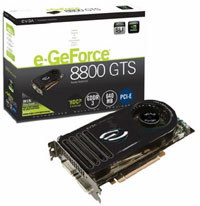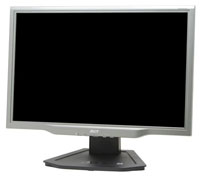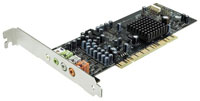Midrange Gaming Configuration
We've covered nearly all of the component choices necessary for a high-quality gaming solution already. The one major change that we would make would be to cut costs in most areas other than the graphics card, and then spend a large portion of the budget on getting a GPU that's as fast as possible. Here's what we came up with.
| Intel Mid-Range Gaming System |
| Hardware |
Component |
Price |
Rebates |
| Processor |
Intel Core 2 Duo E6300 (1.86GHz 2MB Shared) - Retail |
$185 |
|
| Motherboard |
Biostar TForce965PT (P965 775) |
$111 |
|
| Memory |
OCZ S.O.E 2x1GB DDR2-667 (OCZ2SOE6672GK) |
$221 |
$30 |
| Video Card |
eVGA GeForce 8800GTS 640MB (640-P2-N821-AR) |
$400 |
$20 |
| Hard Drive |
Seagate 320GB SATA 3.0Gbps 7200RPM 16MB (Barracuda 7200.10) |
$90 |
|
| Optical Drive |
LG Black 18X DVD+R (GSAH22N-BK) |
$36 |
|
| Case |
Cooler Master Centurion 534 (RC-534-KKN2-GP) |
$66 |
$10 |
| Power Supply |
Rosewill SLI 600W (RP600V2-S-SL) |
$73 |
|
| Display |
Acer AL2223Wd 22" 5ms (1680x1050) |
$314 |
|
| Sound Card |
Creative Sound Blaster X-Fi XtremeGamer 7.1 |
96 |
|
| Speakers |
Logitech X-530 5.1 70W Speakers |
$74 |
|
| Keyboard and Mouse |
Microsoft Comfort Curve 2000 B2L-00047 |
$28 |
|
| Operating System |
Windows XP MCE 2005 (with Vista coupon) |
$115 |
|
| Bottom Line |
|
$1809 |
$1749 |
 |
We pretty much took the base Intel midrange configuration and made several focused upgrades. The most significant change is going to be the inclusion of a GeForce 8800 GTS graphics card, and many people will be content to stop there. The GeForce 8800 GTS features DirectX 10 support (which of course will require Windows Vista and an updated public driver before it becomes useful) and it uses NVIDIA's new G80 core. We can't really evaluate DirectX 10 performance yet, but in currently shipping games the only single GPU solution that's faster than the 8800 GTS is the 8800 GTX. The GTS isn't a whole lot faster than AMD's X1950 XTX, and there are even a few games where it's slightly slower, but given the relatively similar prices and the improved feature set most gamers will prefer NVIDIA's offering right now.
 |
Besides the upgraded graphics card, we felt most gamers would appreciate moving to a larger LCD. We chose the Acer 22" LCD without HDCP support rather than the Sceptre we mentioned on the previous page, because many gamers really don't care too much about HDCP. We also added the larger 600W Rosewill power supply, and in order to get the most out of games we felt the inclusion of Creative's Sound Blaster X-Fi was warranted.
 |
Core 2 Duo generally does very well in gaming benchmarks, and anyone looking at doing even a moderate amount of overclocking will definitely get more mileage out of a Core 2 Duo chip. However, if you spend an equal amount of money on an AMD system, you can get an X2 4600+ that typically falls between the E6300 and E6400 in gaming performance (at stock speeds). Given the number of A-list games that currently benefit from multiple processor cores (all three of them!), you can even take things one step further and pick up a single core Athlon 64 3800+ to save even more money.
That said, we really hope 2007 will finally be the year where dual core processors begin to show more of a benefit in games. With such a high-end graphics card, the CPU could very well become a bottleneck, and several triple-A titles scheduled for the coming year look poised to put more of a strain on the CPU. While it might be interesting to contemplate using a single core processor with a high-end GPU in a gaming system, long-term that may prove to be a limiting solution and we don't recommend it.













43 Comments
View All Comments
Mermaidman - Friday, August 31, 2007 - link
Come on guys, my AMD Barton is getting long in the tooth and UT2007 is around the corner! :)Sunrise089 - Sunday, January 21, 2007 - link
Jarred:Thanks again for another stand-out article. Despite what other may chime in (and the usual complaints by the PSU nazis that want us to spend more on a commodity component then a CPU or motherboard) this new system makes MUCH more sense than having many AMD and Intel options for what had basically become guides based on personel preference rather than rational performance. There is no reason to choose AMD for certain applications, overclocking one of them, just as there is no reason to choose Intel in others (say a sub $100 CPU). Just coming out and saying that through a build list is a wonderfull step in the right direction. I think it's crazy that users still insist on an all AMD or all Intel series of builds, when noone insists on all ATI or all nVidia.
In short, it makes much more sense to break up the builds based on the very different usage requirements - especially due to some users not OC'ing and therefore having totally different CPU, motherboard, and HSF needs than an arbitrary division of the guides based on CPU brand.
Keep up the good work!
SaII - Sunday, January 21, 2007 - link
This article has all the PSU configs wrong, get at least a GOOD branded PSU for an 8800GTSand that 700W PSU for the overclocking config is over the top over-kill.
Give the overclocking one the OCZ 600W PSU and 700W OCZ for the gaming rig.
JarredWalton - Sunday, January 21, 2007 - link
I'd say if you want a really good PSU for overclocking or gaming, plan on spending around $120 or so, which will get you the 700W OCZ listed or a variety of other high-quality 500-600W PSUs. I will take the PSU complaints under consideration next midrange guide, but seriously for gaming (WITHOUT overclocking), the only thing that really needs more than a good quality 400W PSU is going to be SLI/CrossFire setups, and even then 400W is usually enough.sirdowny - Sunday, January 21, 2007 - link
Just out of curiosity, has anyone heard about any problems with the Tuniq Tower 120 and it's massive weight? Seems like it would be a good cooler assuming it were used in a case that sat horizontally (like an HTPC), but am I the only one who has reservations about letting that brick dangle from my motherboard?SaII - Sunday, January 21, 2007 - link
I have it, it works wonders, and the only ones that have problems is user error.Zepper - Saturday, January 20, 2007 - link
Things author should know:1- Rosewill is one of Newegg's in-house packagers. Some folks won't or can't buy from Newegg/ChiefValue which is (I say is because they are the same company) the only place you can get the Rosewill brand except for perhaps some Mom & Pop shops who may buy stock from them.
2- Who actually makes that PSU so the folks referred to above can get one if they want (not that they would when such a unit as the Enhance ENP-5150GH exists with aPFC and full-range AC auto sensing is available for nearly the same money). In most cases Rosewill packages ATNG/Coolmax PSUs - if this IS a Deer then it should NEVER have been recommended - its output ratings are identical to the Coolmax 600 but the physical layout is not.
In any case, recommending Rosewill comes with risks - not the least of which is becoming a laughing stock in the community (again, if this is really a Deer then that might be well deserved). They do package some decent products like the R6A and R560x case lines - but unless you know the history of the OEM of the item, it's a pig-in-a-poke. Caveat emptor!
..bh.
Le Québécois - Saturday, January 20, 2007 - link
Are they really rebranding Deer PSU now? Do you know if any other brand use Deer as base PSU?This is the worst know brand I can think of. When I worked as a technician in a computer store, every time someone brought us a computer with a broken Deer PSU inside, almost every components of the computer had blown at the same time the PSU did. Using Deer PSU in a computer is almost like putting a time bomb in it.
mostlyprudent - Saturday, January 20, 2007 - link
Anyone know whether one of the basic configurations (AMD or Intel) from this article would perform better for a system running primarily Photoshop? I had configured two systems for a friend which are very similar to those in this article and was going to let them decide based on price and the general performance difference between the X2 3800 and E6300. It will basically be a web/email/document PC with the exception of a prosumer Photoshop user.JarredWalton - Sunday, January 21, 2007 - link
Core 2 Duo will typically be a bit faster in Photoshop, although in my opinion having a lot of RAM is more important for most professional PS work. Now if we can just get a 64-bit PS version so people can effectively use 4+ GB of memory.... :)